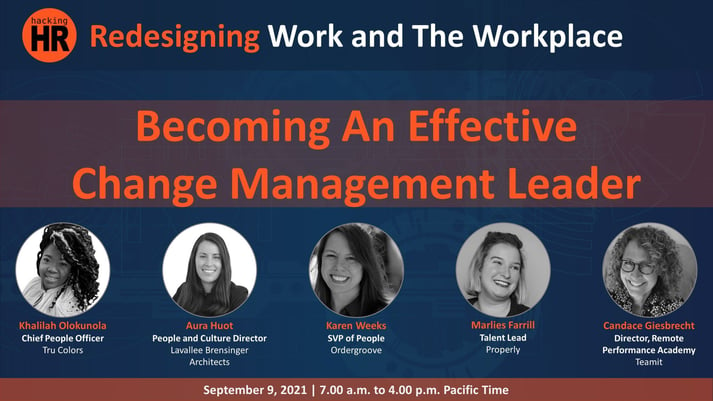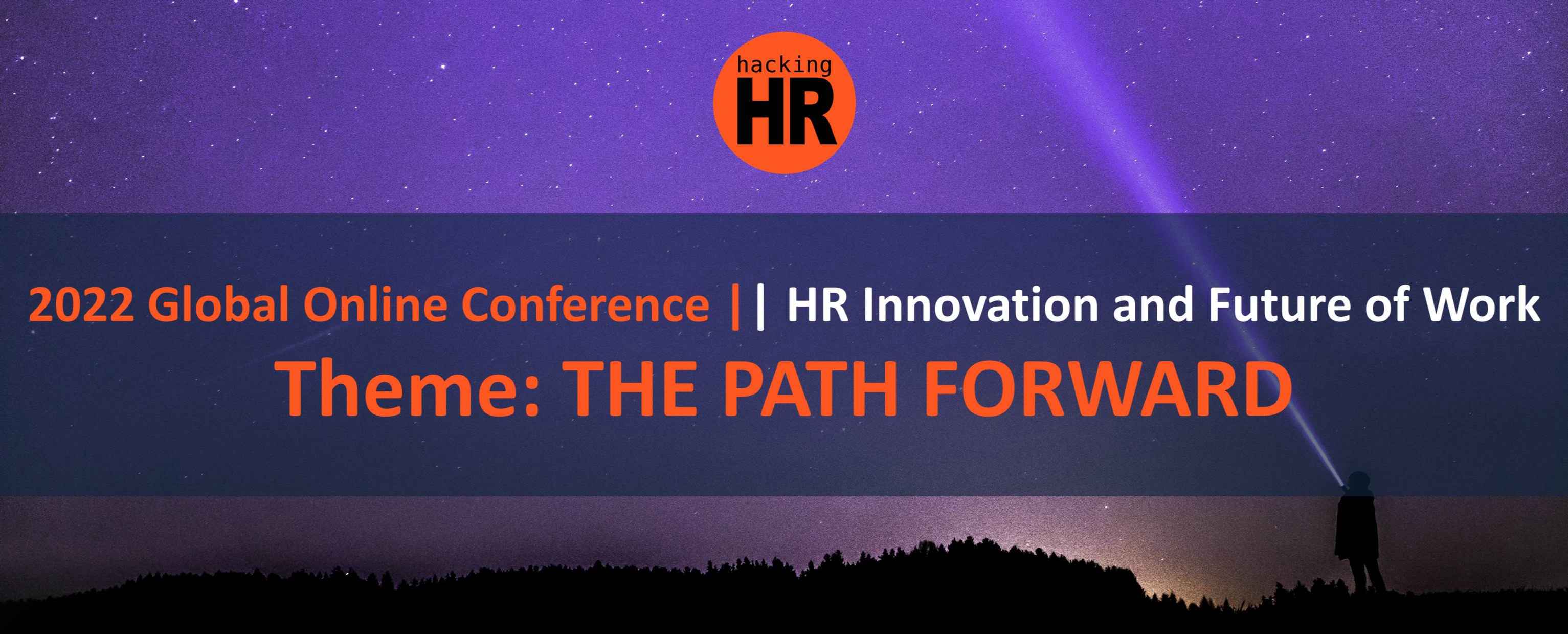Business leaders all over the world are thinking the same thing—how are workplaces and the way people work going to evolve in the next few months? At the beginning of September, Hacking HR held an online event, Redesigning Work and Workplace, to begin to address and navigate the post-pandemic workplace.
We tuned in to the panel session, Becoming an Effective Change Management Leader, moderated by Enrique Rubio, Founder of Hacking HR, to hear from the panelists:
- Khalilah "KO" Olokunola, Chief People Officer at TRU Colors
- Aura María Huot, People and Culture Director at Lavallee Brensinger Architects
- Karen D. Weeks, SPHR, MS, SVP of People at Ordergroove
- Marlies F., Talent Lead at Properly
- Candace Giesbrecht, Teamit’s Director of Talent Strategy

The panel discussion focused on the foundations of change management and how to lead change management in times of disruption and chaos. Let’s dive into four key learnings from the session.
Learning #1: Be transparent throughout the entire process and communicate.
“We need to ensure that we involve people and make it inclusive of all. Transparency throughout the process is key,” says Aura.
HR leaders wear many hats; they are advisors, coaches, partners, and the objective voice in the room when they are helping the leadership and management team communicate change management noted Karen. Showing the rationale behind the change is crucial. This helps employees “not only understand, why you're doing the change in the first place but what else was taken into consideration before the determination was done,” said Karen.
With transparency also comes communication. It’s common for organizations to talk about the excitement for the change and communicate at a high level what it means for the organization, but this also needs to be communicated to individual employees. “A big part of this is being really clear about why the change is happening and what that means for individual employees,” said Marlies.
From Khalilah’s perspective, showing people how they fit in, what part they play in the puzzle, that they’ve been heard, and their input has been considered, builds a collective team. When it comes to implementing something new, we all know that change can be hard. By being open about this, people feel less discouraged.
We also need to remember when we have implemented change “that how the person is showing up today is part of their process and honouring that peoples’ process may twist and turn a couple of times before they get to that new beginning,“ noted Candace.
Learning #2: Be approachable, an active listener, and build relationships and trust.
As HR leaders there are skills and competencies that are crucial for being an effective change management leader in order for employees to feel supported through change.
“It’s important to remember that we’re here to be a supportive place and safe place at work,” said Candace. That means “sending that message to the employee that we care about you, and we care about this workplace, and we’re here to help you do well in your workplace.”
When it comes to building relationships and trust, we need to realize we’re all human and empathy and active listening are essential. “Leading with the best intent and recognizing everybody's coming with different perspectives, we need to understand that perspective before we figure out how to help them,” said Karen. It’s okay to be vulnerable and admit when something was missed. This is “one of the best ways to build trust and approachability,” she added.
Although active listening is critical, we need to also listen to what employees don’t say. “Silence is still a conversation,” said Khalilah. “That includes learning your cues, both your IQ (what you know), your EQ (emotional intelligence) and your AQ (what to do with what you know). It’s through those emotions that I experience, that HR has to begin to discover themselves.”
Learning #3: Be open when you make a mistake, find your champions and analyze the state of your business as a whole.
To make an effective change, we need to analyze the current and future state of the business. Once a change has been implemented, we need to “assess what went well, what didn't because those notes can really help us do things better next time and learn from our mistake,” Aura said.
“At a high level, we’re measuring our people, our purpose and our profit,” said Khalilah. When it comes to the people level, we’re asking employees not only are they happy but are they fulfilled. The purpose is tied to our why and ensuring we are addressing those things that we say we are in our mission statement. For the profit part, it’s about making sure we’re hitting those numbers. Looking at these key areas, determine what needs to be addressed. “Those high-level components cause ripple effects in all other areas of your company—people affect culture, purpose, affects belief, profit, affects the bottom line,” Khalilah concluded.
Another key component is to look at your important stakeholders and monitor them closely for any signs of resistance which will then make it difficult to make the change successful. “Find your champions, don’t miss them. You can say everything right. The managers can say everything right. But when they see their peers starting to get bought in, that's more powerful than anything we will say,” said Marlies. “When a lot of change happens, it's easy to be focused on the very end goal. Make sure you’re celebrating the small milestones,” emphasized Marlies.
Overall, we need to remember we are human and it’s natural to make mistakes, have questions and ask for help. This is part of learning, experimenting and growing.
Learning #4: Be clear by connecting the message to the outcome you’re trying to achieve.
When it comes to engaging and convincing your champions in the organization, it's important for leaders to be transparent and communicate with clarity the rationale behind the change. So, what are some ways to do this?
When we are working with business leaders, we need to ask them, “what are you trying to accomplish and then try to coach them backwards to what those key messages are and what becomes important,” said Candace. The key is asking ourselves “what do I want people going away with and what are the one or two things I want them to think and feel now.”
We can also connect the message to the outcome we’re trying to achieve, “by helping leaders see it from someone else’s perspective,” said Karen. Applying the learnings from the book, Leadership and Self-Deception, “I have often said to leaders who have been in the thick of things, that maybe don't see it from a very frontline workers perspective, let me say back what you're about to tell this team,” Karen said. By doing this exercise it helps leaders see and understand a different perspective and take note of how it made them feel and questions they have if they didn’t have any context.
In addition, when we communicate, we also need to take the opportunity to listen. “If you don't fill in the blanks for why you're doing this and why this is happening, in the absence of information, people don't like that gap, and they fill it in themselves and you have no idea what they're going to fill in there,” said Khalilah. Her suggestion is to create a change impact assessment to figure out what’s happening in your organization and then using the data, create a communication plan.
Register for Hacking HR’s 2022 Global Online Conference
Hacking HR’s Global Online Conference “The Path Forward” is taking place from March 7 to 11, 2022. This is a free conference that includes 600 speakers, 300 sessions and 40,000 participants!
Our Director of the Remote Performance Academy, Candace Giesbrecht, will be speaking at the following panel sessions:
- Panelist on: Cultivating Leadership Skills and Organizational Capabilities to be Future-Ready
Panelist on: Developing Future Scenarios and Their Implications for Business and HR - Moderator for: Understanding the Principles of Strategic Foresight
Be sure to tune in! Learn more and register today.

